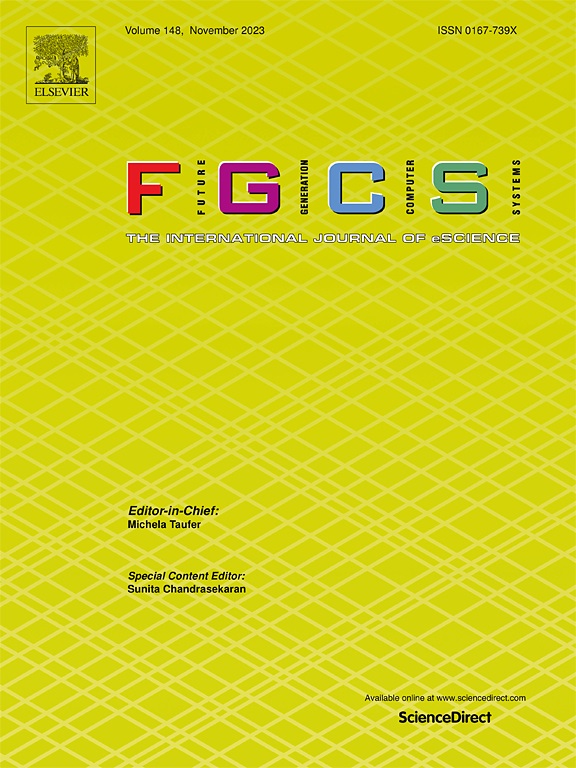Blending lossy and lossless data compression methods to support health data streaming in smart cities
IF 6.2
2区 计算机科学
Q1 COMPUTER SCIENCE, THEORY & METHODS
Future Generation Computer Systems-The International Journal of Escience
Pub Date : 2025-02-11
DOI:10.1016/j.future.2025.107748
引用次数: 0
Abstract
The digital transformation process has significantly boosted the widespread adoption of telemedicine and the utilization of wearable devices for vital signs remote monitoring. However, implementing a system for continuous monitoring of the population’s vital signs, with data being streamed from various locations within a smart city context, faces significant challenges. These challenges are related to bandwidth consumption, communication latency, and storage capacity due to the large volume of data. To overcome these challenges, a common practice consists in modeling an edge-fog-cloud layered architecture. The literature lacks software solutions capable of managing the simultaneous transmission of various vital signs data from geographically distributed individuals while maintaining the ability to generate health notifications promptly. In this context, we propose the VSAC (Vital Sign Adaptive Compressor) model, which combines lossy and lossless data compression algorithms in a layered architecture to support healthcare demands in a smart city. The main contribution is how we blend both strategies: we first use lossy compression to collect only valuable vital sign data for everyone, applying lossless algorithms afterwards to reduce the number of bytes before sending it to higher layers. We provide a real-time processing protocol that facilitates the collection of heterogeneous data distributed across different city regions. After executing a VSAC prototype, the results indicate that orchestrating the aforementioned two data compression algorithms is more efficient than conventional data reduction methods. In particular, we obtained gains of up to 42% when measuring the compression rate metric.
混合有损和无损数据压缩方法,支持智慧城市中的健康数据流
数字化转型进程极大地推动了远程医疗的广泛采用和可穿戴设备对生命体征远程监测的利用。然而,在智能城市背景下,实现一个持续监测人口生命体征的系统,并从不同地点传输数据,面临着重大挑战。这些挑战与带宽消耗、通信延迟和由于大量数据而导致的存储容量有关。为了克服这些挑战,一种常见的做法是对边缘雾云分层架构进行建模。文献中缺乏能够管理地理分布个体的各种生命体征数据同时传输的软件解决方案,同时保持及时生成健康通知的能力。在此背景下,我们提出了VSAC(生命体征自适应压缩器)模型,该模型在分层架构中结合了有损和无损数据压缩算法,以支持智慧城市的医疗保健需求。主要的贡献是我们如何混合这两种策略:我们首先使用有损压缩来收集每个人有价值的生命体征数据,然后在将其发送到更高层之前应用无损算法来减少字节数。我们提供了一种实时处理协议,便于收集分布在不同城市区域的异构数据。在执行了一个VSAC原型后,结果表明,协调上述两种数据压缩算法比传统的数据约简方法更有效。特别是,在测量压缩率指标时,我们获得了高达42%的增益。
本文章由计算机程序翻译,如有差异,请以英文原文为准。
求助全文
约1分钟内获得全文
求助全文
来源期刊
CiteScore
19.90
自引率
2.70%
发文量
376
审稿时长
10.6 months
期刊介绍:
Computing infrastructures and systems are constantly evolving, resulting in increasingly complex and collaborative scientific applications. To cope with these advancements, there is a growing need for collaborative tools that can effectively map, control, and execute these applications.
Furthermore, with the explosion of Big Data, there is a requirement for innovative methods and infrastructures to collect, analyze, and derive meaningful insights from the vast amount of data generated. This necessitates the integration of computational and storage capabilities, databases, sensors, and human collaboration.
Future Generation Computer Systems aims to pioneer advancements in distributed systems, collaborative environments, high-performance computing, and Big Data analytics. It strives to stay at the forefront of developments in grids, clouds, and the Internet of Things (IoT) to effectively address the challenges posed by these wide-area, fully distributed sensing and computing systems.

 求助内容:
求助内容: 应助结果提醒方式:
应助结果提醒方式:


